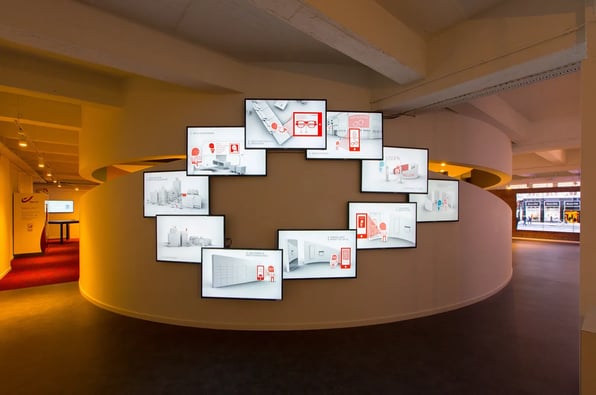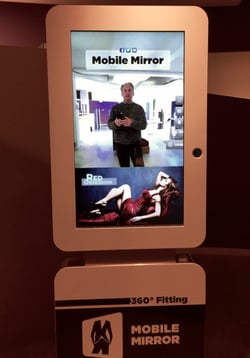How The Retail Store Of The Future Illuminates Retail Trends

Subscribe to our newsletter
Updated 6/13/23
Everyone is busy trying to understand and predict the future of shopping and in retail in particular.
But too many retailers have their heads down, ignoring any new development as pie-in-the-sky or irrelevant to them. They just want to get through each day.
That’s a problem when the very nature of shopping is changing.
After keynoting at the Retail Congress in Antwerp, I was fortunate to visit The Loop, Retail Detail's knowledge lab, where the future of retail is studied. There among the cobblestone streets, ancient mansions, and a thriving metropolis, I found a focus on understanding shoppers and retail startups like I've never seen before.
Jorg Snoeck, founder and CEO of Retail Detail, explained why The Loop was created. He said, "As a retailer, you have to concentrate on three critical issues today: the smart use of omnichannel, the experience for the customer, and your relationship with that customer's movements in the market. However, things are moving so rapidly that the retailer is almost hopeless to even see his own forest for the trees."
It's called the Loop because Retail Detail has identified the ten stages of a buyer's journey: their original inspiration to purchase, through that item making its way into their home, and then onto their next inspiration. They have mapped out each shopping experience stage to see how technology plays a part.
While some call it omnichannel, many retailers are simply referring to it as the complete or seamless sales journey, the idea being there is no separate buying channel - online, offline, retail store, mobile, or kiosk path - they all work in tandem. Rather than trying to identify and measure each one, the smart retailer must look at the entire customer journey loop.
The Customer Journey...The Loop:
Stage 1 – Inspiration and need realization. Shoppers are inspired by something they see in a window display or on a co-worker, or in a magazine – you name it. They can’t buy the item right when they see it because the store might be closed or they don’t have time to research it further.
Stage 2 – Information Gathering. They do an online search for the item either with a QR code that takes them directly to the retailer's product page or they conduct a general search on Google. Nearly 63% of shoppers start their buying journey online before purchasing in a store.
Stage 3 – Decision making and ordering. They order it online using the Click-and-Collect option or what we in the States call the Buy-Online, Pickup-In-Store option.
Stage 4 - Home to store. They travel from their home to the store at a reserved time.
Stage 5 – Entering the store. They go to a dedicated pickup area or a personal assistant in the store.
Stage 6 – Staff & Product Encounter. The employee builds trust and rapport and is engaged.
Stage 7 - Outfitting. While the shopper examines the item they ordered, the employee offers additional items, which may be online or in-store.
Stage 8 - Checkout and point of sale. The customer pays for both in-store and online items which will be delivered.
Stage 9 – Delivery of online items at home.
Stage 10 - Re-trigger. Shopper seeks new inspirations, and the Loop begins again.
Teach Your Dealers The 30 Trends In Retail Everyone Should Know
Understanding all these touch points has helped Retail Detail spotlight some of the best technology in their learning lab, and it is constantly changing as a result.
Here are four technologies I think are pretty smart:
-
Virtual mannequin. Using their smartphone or touching the film on a retailer’s window allows shoppers to customize an item on a mannequin and shop - even when the store is closed. It can also be used in-store.
-
Mobile mirrors. These cameras feature a time-delay display allowing customers to turn around and see a 360-degree view of themselves while trying on clothing.
-
Hologram customization. While many websites now offer customization, a 3d hologram makes the process easy and interesting on your sales floor. Watch this under a minute video below.
-
Magnetic RFID-enabled POS systems. By using magnets instead of pins for theft protection, holes in the garment are no longer a worry, but more than that, radio frequency ID tags keep cashiers from entering lower prices for friends. And makes inventory a breeze. Watch to see how it's done, then read more about RFID technology.
The challenges in retailing do not go away with technology tools; they just change.
Whoever had the must-have product used to own the market. Now it will become about access to that product through the omnichannel customer experience, not just stocking it.
For example, while it will be easy to embed a QR code into a magazine or TV, that code will only go to one retailer. Who gets the ownership of the code wins the purchase as shoppers can purchase from anywhere.
Grocery stores already fear the Amazon dash buttons allowing customers to add to their online shopping lists. Going one step further, the upcoming Internet of Things (IoT) Appliance will be connected to online retailers and be able to reorder supplies automatically.
Just think of an intelligent washer that knows you are about to run out of detergent and orders it for you. That means your ability to attract a customer to a new detergent in-store becomes much more difficult for two reasons - shoppers won't go down your detergent aisle anymore. They won't want to reprogram their IoT appliance.
In addition, stores are getting much smaller. With the advent of just-in-time production, stores will no longer need 10,000 square feet to house all the clothing sizes so stores will shrink. This explains one of the fastest-growing trends in retail, shipping containers being turned into boutiques of just 400 square feet.
Yes, we're looking at a future of much smaller, more entrepreneurial stores that don't have to become the next H&M or Starbucks but can be happy just serving their local trading area. Look no further than the craft beer craze for the popularity of buying local.
With the waves of retail bankruptcies far from over, expect real estate to come down in price, which will make it much more affordable for smaller operators to open compelling and interesting stores; consider a produce store that has a live feed to the chickens laying the eggs or a clothing store where merchandise is created on 3D printers based on the styles shoppers voted for on their smartphones and then displayed in-store the next day.
Who knows what they’ll come up with, but I’ve seen the future, and it’s smaller.
As stores get smaller, curating a collection will be easier. You will need to develop a very clear point of view that enables shoppers to understand what you sell. Instead of aiming for the mass market, you must find new ways to tell your story to a growing tribe of established and future followers.
On top of that, the Minimalism movement is growing. People are surrounding themselves with less and less stuff in smaller places.
When reviewing what they will bring into their homes, the adherers of Minimalism simply ask themselves, “Does this bring me joy?” If it doesn’t, they don’t buy it.
The more things change, the more they stay the same
What won’t change is the major leak in most retailers’ customer experience, the employee working on the floor who is disengaged, disempowered, and dislikes working retail. When your customers enter your doors, they’ll pour cold water on their flames of inspiration.
That’s nothing new...
What is new is how smart retailers are embracing the future and looking at new tools to add to their arsenal against the Amazon and Alibabas of the world. Coupled with an enthusiastic salesperson who can get the consumer to trust them, and by extension the brand, smart retailers are coming up with something greater than the sum of their technological parts.
They may be adding holographic customization to their customer experience without assuming the holographs on their own are engaging. Others are using actual on-the-product augmented reality video - yes, it’s a cookie box that talks - that speaks to customers one-on-one to showcase product ingredients, fashion tips, or gee-whiz ideas.
That’s because the future of retail has to go beyond just passing out iPads to save a clerk from checking the stockroom. It has to start with the customer. They left their home because they were bored with their tablet and craving a human-to-human experience, not a virtual reality experience.
No, you can’t turn your store into just a warehouse of virtual life to hide the real fact you have a boring store.
Retail sales training will be more important than ever by giving your employees the steps to build rapport and trust! It will allow you to sell what you have in store and gently challenge customers who think they know what they want by showing them something even better. It will keep your customers loyal to you, and you will stay in their Loop.
In Sum
Various readers follow this blog - from global brands and think tanks to one-off retailers and their crews. No matter what size you are, you need to look at how you are showing up in your potential customers’ lives and where you are in each of the ten stages of the retail experience Loop.
Once you see where you could do better, look at the options, consider your resources, and sketch out a plan.
It isn't the big that will beat the small, it is the creative that will devour the uninspired.

.webp?width=102&height=111&name=Map-NYC%20retailers%20(1).webp)

